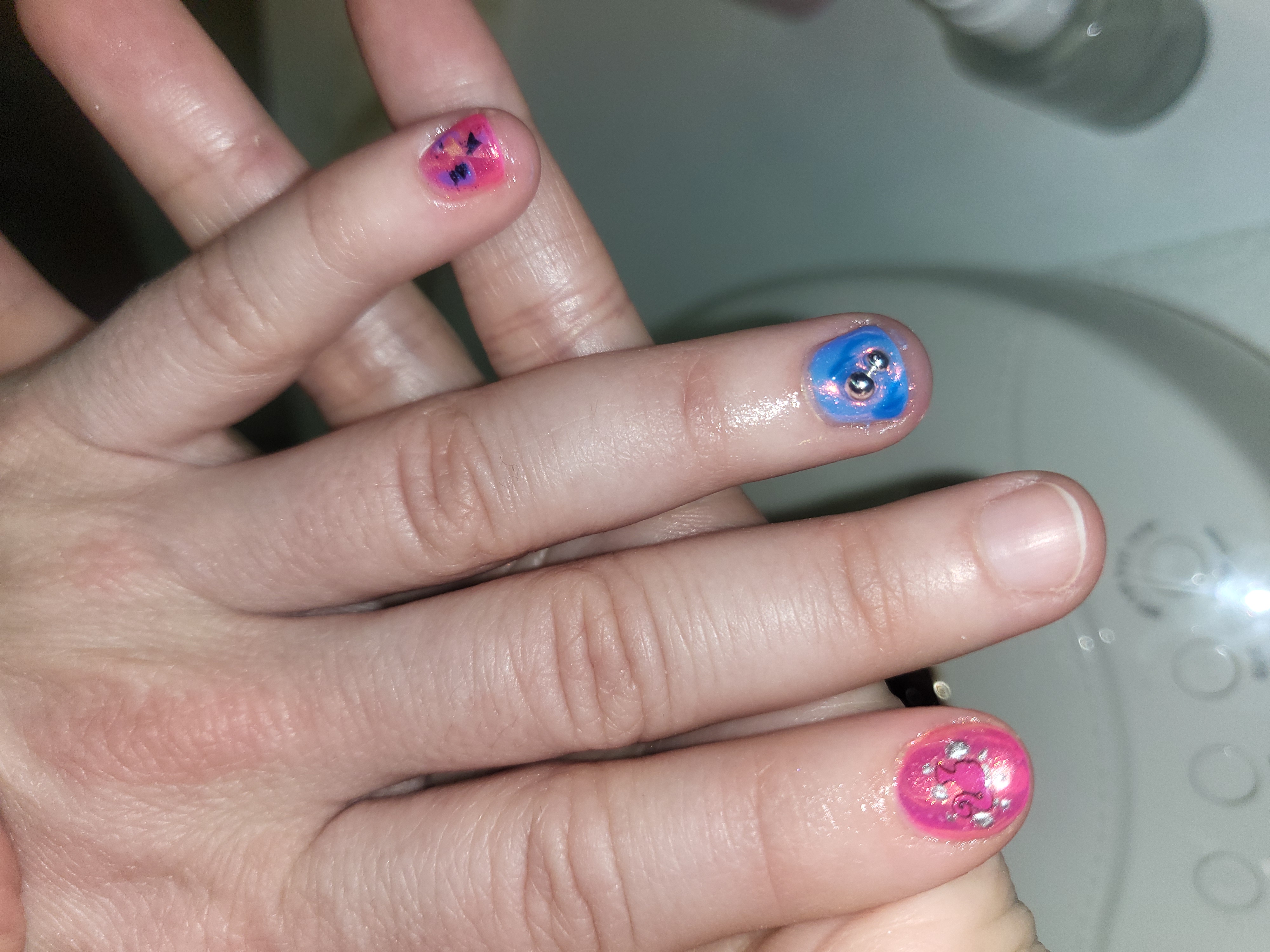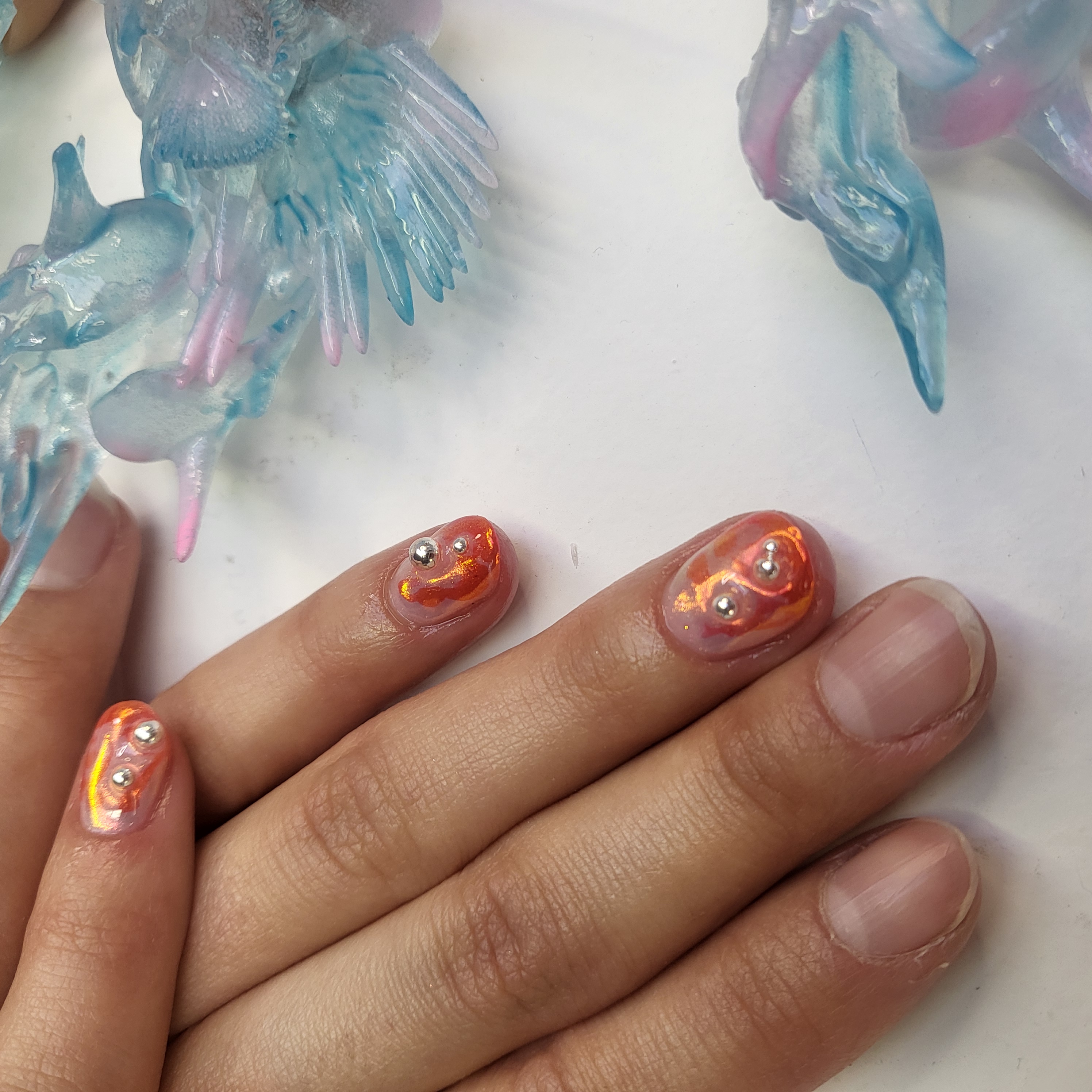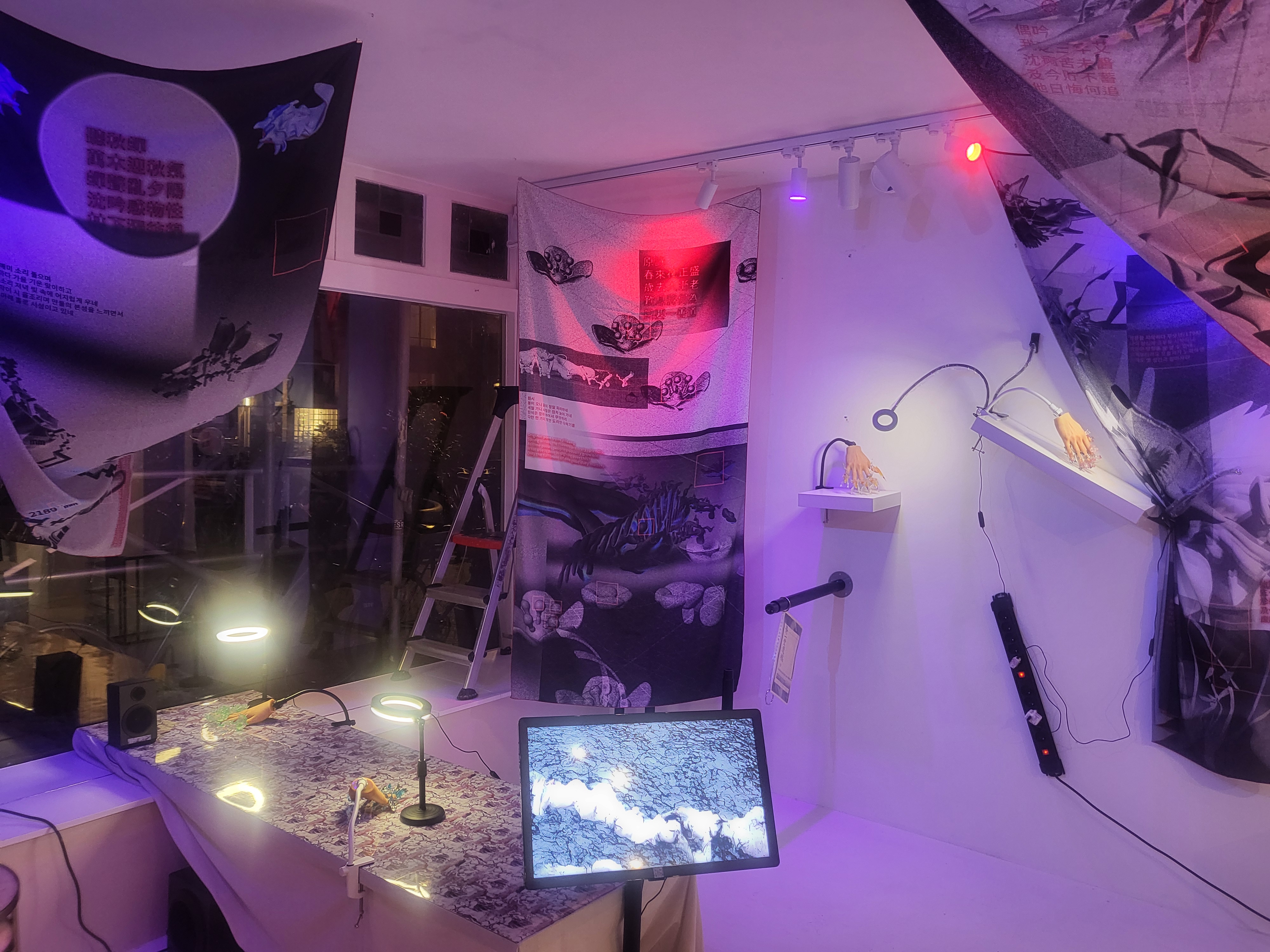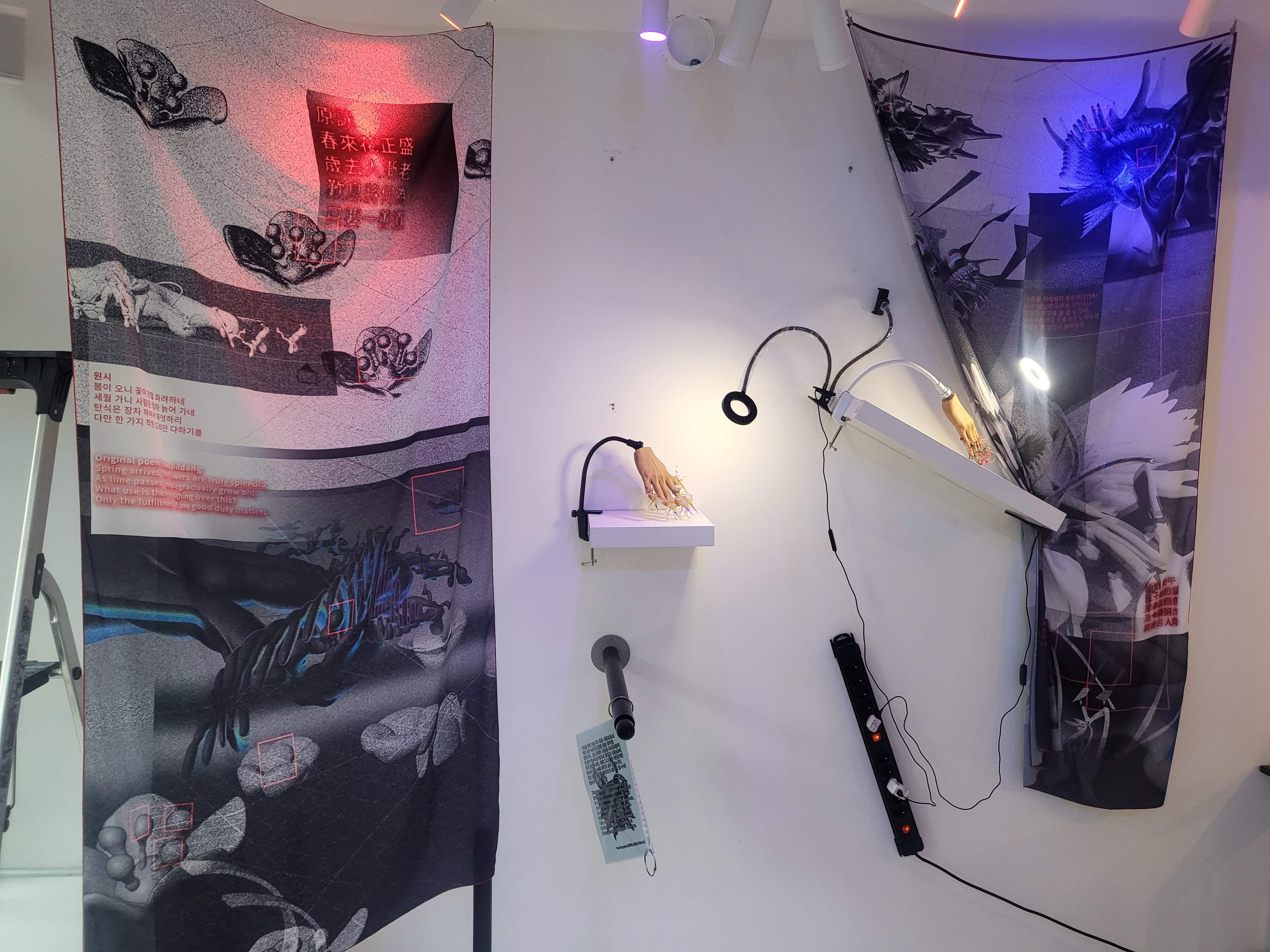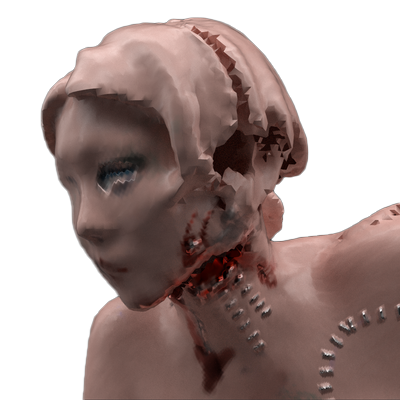At the Tip of the Hands & Invisible Voice

At the Tip of the Hand
-Sungyoon AhnSome things take shape at the tip of the hand.
The ink that bleeds from the tip of a brush, the colours that fill a nail tip, the conversations unfolding as the polish slowly dries.
The act of manicuring is more than mere decoration–it is a gesture woven with care and labour, intimacy and tension. “At the Tip of the Hand” is a space where different languages, histories, and bodies overlap through the medium of hands. Just as nail art and sagunja (the traditional Korean painting of Four Gentlemen) intersect, so too does the act of manicuring with women’s lives.
When I first encountered Chego’s work, I was drawn to her experimental process of layering images across Korean traditional painting, AI, and digital tools. I would describe this process as a kind of ‘hybrid painting’, where different visual languages do not merely coexist but engage in a dynamic exchange. Sometimes they clash, sometimes they blend seamlessly. On her canvas, images accumulate, dissolve into one another, and at some point, evolve into new forms whose origins are no longer discernible.
Observing her work, I am reminded of how an individual absorbs, resists, and transforms within a cultural landscape. As a Korean artist living in Europe, Chego inhabits the very essence of ‘merging’–not just as a technical process, but as a lived experience. It is an embodied negotiation of estrangement and assimilation that seeps into her painting.
I find myself returning to the recurring motifs in her work–self-portraits, fragmented faces, hands. They appear disjointed, yet rather than pushing against one another, they continuously connect and regenerate within the same space. The bodies she portrays are not mere representations; they are layered embodiments of experience and sensation, entities in flux, constantly shifting and reshaping.
Since returning to Korea, Chego has also become a licensed nail technician. Nail art has become an extension of her daily practice, bridging her artistic and physical labour. In Four Noble Hands, one of her recent works, she brings together nail art and sagunja—a painting tradition that once symbolised the refined taste of Joseon-era male scholars. Here, she intervenes in traditional aesthetics, juxtaposing vivid nail tips with the restrained elegance of sagunja brushwork–an intrusion both playful and defiant.
This intervention expands further in Four Noble Hands with Jeonildangyugo, a digital print juxtaposing 3D-rendered nail art with the poetry of Gang Jeonildang, a Joseon-era female poet. Denied the right to publish her work during her lifetime simply because she was a woman, Gang’s words were only recognised posthumously through the efforts of her male descendants. By reclaiming the visual language of sagunja, once considered a masculine aesthetic, Chego revives a voice that had been erased.
My publication made alongside the exhibition explores the nail salon as a space of labour and social exchange. The act of two women holding hands, applying polish, and waiting for it to dry is more than a beauty ritual. It is a moment of care, but also a reflection of the social expectations placed upon ‘cultivated’ bodies and the invisible work behind them. Beneath a flawlessly coated nail, unseen bodies persist—serving, tending, remaining out of sight.
For this research, I gathered fragments—internet memes, news articles, literary excerpts, historical paintings—piecing them together into a small collage. Through these disparate elements, I sought to trace the tensions and sensations embedded in everyday gestures.
The exhibition At the Tip of the Hand follows the traces left by these acts. It is another hybrid imprint of crossings, where past and present intermingle, where silence and voices overlap. The flowers blooming on nail tips carry the traces of erased voices, the imprint of care, and the quiet shimmer of untold stories waiting to be heard.
손끝에서 시작되는 것들
-안성윤손끝에서 시작되는 것들이 있다.
붓끝에서 번지는 먹, 네일팁 위로 채워지는 색, 매니큐어가 굳어가는 동안 나누는 대화들.
매니큐어를 바르는 행위는 단순한 장식이 아니다. 그것은 돌봄과 노동, 친밀함과 긴장이 얽힌 몸짓이다. <at the tip of the hand>는 손이라는 매개체를 통해 서로 다른 언어, 역사, 몸들이 겹쳐지는 공간이다. 네일아트와 사군자가 교차하듯, ‘매니큐어링’이라는 행위는 여성들의 삶과 교차한다.
처음 최고은 작가의 작업을 마주했을 때, 한국 전통 회화, AI, 디지털 도구를 넘나들며 이미지를 겹쳐 나가는 그의 실험적인 과정에 매료되었다. 한 화면 안에 서로 다른 문화와 시각이 융합되고 혼합되는 이 과정을 나는 일종의 ‘교배의 회화’라고 표현할 수 있을 것 같다. 단순한 ‘병치’를 넘어 마치 서로 다른 언어가 대화하듯, 때로는 충돌하고, 때로는 자연스럽게 스며든다. 그의 캔버스에서는 이미지들이 겹겹이 쌓이며 서로 흩어지고, 어느 순간 그 기원이 분명하지 않은 새로운 형태로 태어난다.
그의 작업을 볼 때면, 마치 한 개인이 특정한 문화 속에서 흡수되고, 저항하고, 변화하는 과정을 보는 것 같다. 유럽에서 활동하는 한국인으로서 최고은 작가는 ‘merge’라는 개념을 실생활에서 몸소 경험하고 있다. 그에게 이것은 단순한 기술적 용어가 아니라, 존재의 방식이자, 익숙함과 이질성 사이에서 끊임없이 조율해야 하는 감각이다. 그가 경험한 이질성과 동화의 순간들은 고스란히 회화 속에 드러난다.
나는 그의 작품 속에서 반복적으로 등장하는 작가의 자화상, 파편화된 얼굴들과 손들에 유독 눈길이 간다. 그들은 마치 조각난 듯 보이지만, 서로를 밀어내지 않고, 오히려 한 화면 안에서 끊임없이 이어지고 다시 태어난다. 그가 그리는 몸들은 단순한 형상이 아니다. 그것은 경험과 감각의 층들이 쌓여 만들어진 존재이며, 끊임없이 변형되고 재구성된다.
최근 한국으로 돌아간 최고은 작가는 정식 네일 테크니션으로 활동하며, 네일 아트는 그의 일상과 예술을 잇는 중요한 연결고리가 되었다.「Four Noble Hands」, 2024는 그의 최신 작품으로 네일아트와 사군자(조선시대 남성 문인들의 교양을 상징했던 회화 장르)가 만나는 작업이다. 여기서 그녀는 전통적인 미적 규범을 방해하듯 화려한 네일팁을 얹는다.
「Four Noble Hands with Jeonildangyugo」,2024에서 이 개입은 더욱 확장된다. 이 작업은 조선시대 여성 시인 강정일당의 시를 3D 네일아트 이미지와 병치한 디지털 프린트 작품이다. 생전에 여성이라는 이유만으로 자신의 시를 발표하지 못했던 강정일당은 사후에야 그의 남편에 의해 문학사에 기록되었다. 최고은은 한때 남성들의 미학으로 여겨졌던 사군자의 형식을 빌려, 강정일당의 지워진 언어를 다시 불러낸다.
이 전시를 위해 내가 제작한 소책자는 네일 살롱이라는 공간과 그곳에서 형성되는 관계들을 탐구하는 리서치 작업이다. 두 여성이 서로의 손을 맞잡고, 매니큐어를 바르고, 굳기를 기다리는 과정은 단순한 미적 행위를 넘어선다. 그것은 돌봄의 제스처이지만, 동시에 ‘가꾸어진’ 몸을 향한 사회적 요구와 그 뒤에 숨겨진 보이지 않는 노동을 드러낸다. 완벽하게 코팅된 손톱 아래에는, 돌보고, 봉사하고, 감춰진 채 남아 있는 ‘보이지 않는 몸들’이 있다.
이 리서치를 위해 나는 인터넷 밈, 기사, 문학 작품의 발췌문, 역사적 회화 등 여러 조각들을 모아 작은 콜라주의 형태로 엮었다. 그리고 이 파편들을 통해, 우리의 일상적인 몸짓 속에서 놓치고 있는 긴장과 감각들을 더듬어보고자 했다.
전시 “At the Tip of the Hand”는 손끝에서 시작된 흔적을 따라가는 과정이다. 과거와 현재를 연결하는 또 하나의 교배된 흔적이자, 손끝에서 이어지는 침묵과 목소리의 겹침이다. 결국 네일팁 위에 피어난 꽃들은 지워진 목소리의 흔적을 품고 있으며, 돌봄의 자취를 남기고, 아직 들려지지 않은 이야기들의 조용한 반짝임을 머금고 있다
![]()
![]()
![]()
![]()
![]()
-Invisible Voice-
